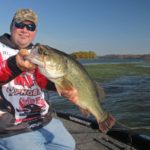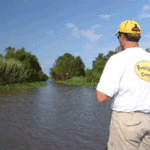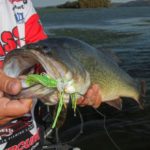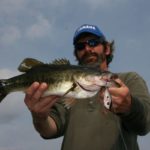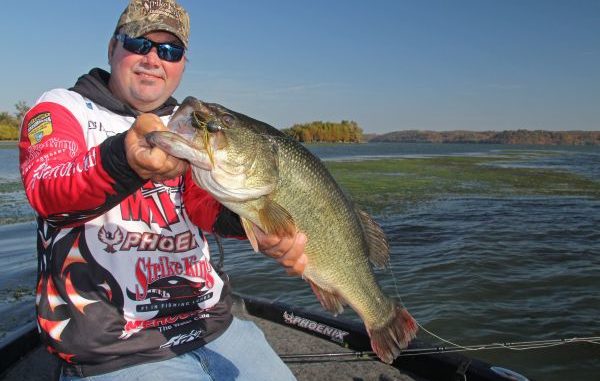
The prespawn can be maddening, as cold fronts roll through and impact the bass bite. Here are some tips from the pros to help fill out your stringer, even when things get tough.
Pickles and ice cream, donuts with lots of sprinkles, Cheese Whiz and anything with chocolate — pregnancy cravings are a fact of life, for a soon-to-be mom eating for two (or more).
Expectant bass might not crave anything odd, but they’re all about packing their bellies for their forthcoming spawn. Learn where and how to locate these fish and you can, ahem, “expect” your own delivery of rod-bending fun.
First, consider the basics of where they’ll spawn. Creeks, coves, backwater canals. Pretty much any shallow habitat with good sunlight and some type of cover will do.
During the prespawn, the fish will be transitioning out of their deep winter patterns, so expect them to stage somewhere between these cold-season retreats and the maternity ward.
Precise depth ranges and particular habitats will vary with individual waterways, but start in local mid-depth ranges and ease your way shoreward. Look for the last significant piece of structure or aquatic vegetation prior to the spawning shallows, and that’s where the fish will set up shop for a few weeks.
It’s probably never a great time to be a bluegill, shad or crawfish, but the prespawn is particularly tough because every female bass of reproducing age will be patrolling this staging zone and gobbling up just about anything they can find.
Now, coming out of the cold season, the fish can still be a little slow to go, but as they settle into this transitional season, they’ll soon adjust their focus and then it’s game-on.
Of course, Mother Nature often saves a few chilly tricks for early spring, and when one of those late-season cold snaps blows through your area it can change things in a hurry. Remember, the fish still need to feed, but a bass is still a bass and cold spells require prespawn adjustments.
For this promising time of the year, we sought input from local pros who shared their insight into the prespawn season. Here’s what they had to say:
Greg Hackney
On the Red River, the Bassmaster Elite and FLW Tour pro from Gonzales hunts prespawners in lily pad fields, shallow parts of stump field — the ridges next to the channel.
On large lakes like Toledo Bend, Hackney looks for bass to move to the inside edges of grass lines, especially hard sand or clay places within the grass.
In eastern Louisiana, along the Mississippi River’s course, old river oxbows are loaded with cypress swamps where big prespawners favor isolated trees.
“Those isolated-tree fish are all big fish, and you can run a pattern on them and they’ll all be 5-pounders,” Hackney said. “There will be one tree out by itself, and that’s where those big prespawn females will get on.”
Hackney also looks for prespawn bass around the mouths of dead-end canals in marshes like those of Bayou Segnette, Venice and the Atchafalaya Basin. The water here is much cozier than the Mississippi’s seasonal temperature.
“Those are the places they’re going to spawn, and those are the places that warm up the quickest,” he said. “In a lot of places where that river water is running through, that water is extremely cold and the fish will move to those dead-ends because they’re warmer.
“They seem to stack up around the points and the mouths of those places first before they move back and start to scatter out with the spawn.”
Hackney’s No. 1 prespawn bait is a Strike King Redeye Shad. He can cover lots of water with it, and when he locates aggressive prespawners the lipless crankbait can be a big producer.
When he’s fishing prespawners around wood, he’ll go with a Strike King KVD 1.5 or 2.5 squarebill crankbait and trigger strikes by deflecting off the hard stuff.
Reaching into the saltwater tackle, the heavy vibration of a Strike King Redfish Magic (a single-bladed spinnerbait) can be a highly productive prespawn bait — especially when slow-rolled.
For flipping, Hackney knows prespawners want a big profile, but they need a slower presentation than they like during the warmer months, so he’ll drop down from his benchmark ¾-ounce Strike King Hack Attack jig to a 3/8- or a ½-ounce model. He’ll seldom fish anything smaller than a 3/8 ounce jig; if he needs to slow his presentation even more, he’ll simply bulk up his bait’s backside.
“It seems like (prespawn fish) want a big, slow-moving bait,” Hackney said. “I really like the Strike King KVD Chunk over the (more active) Rage Craw, and the reason for that is that I really don’t want much action. I just want that big profile and slow-moving bait.
“It seems like I get a lot more bites this time of year on the Chunk because the fish want that big profile, but they just don’t want that aggressive action. They want that action more during the spawn when they’re in that defensive mode, rather than a feeding mode.”
Hackney noted that, because the prespawn range is usually a good bit deeper than the shallow spawning areas, staging fish don’t necessarily make any drastic moves when a late-season cold snap interrupts their seasonal advance. What’s more likely, he said, is a bad case of lock jaw.
Of course, the level of bass reaction depends largely upon the severity of the weather.
“It has to be something that drops the water considerably,” Hackney said. “Say the water has gotten up to 50 degrees and (a cold spell occurs), and it falls back just a few degrees; those fish just seem to lock down wherever they were.
“It seems like you need to have an extended period of cold weather, like a week or more, to pull them back to winter time. If you just get one of those little, short cold snaps that last a couple of days and the weather warms back up, it doesn’t seem like those move the fish back out. You have to have one of those arctic blasts that last for about a week to push them back.”
That’s especially true for larger fish.
“I’ve found that, especially those better fish — those bigger females — the weather doesn’t affect them as much as we once thought it did,” Hackney explained. “It seems like they know, ‘Hey, there’s going to be a cold snap, so we’ll just lock down here and then wait it out.’”
Nevertheless, when temperatures drop during the prespawn, Hackney downsizes line size on his lipless and squarebill crankbaits from 17- to 20-pound test to 12-pound test. Any smaller and he feels he’s sacrificing too much line strength, especially around grass.
If he needs to reach deeper on the lighter line, he’ll just go with a larger crankbait.
With the jigs, he’ll downsize to a Strike King Bitsy Bug with a KVD Junior Chunk trailer and fish it on 10- to 12-pound line.
For these cold-weather interruptions, Hackney knows persistence and repetitive casts are essential — as is bait impact.
“I want to hit the structure with my bait,” he said. “I almost want to crash that bait into that fish, especially after a cold front.
“When those fish are locked down, I need to hit that fish with my bait.”
Paul Elias
This Elite Series and FLW touring pro from Laurel, Miss., looks for prime prespawn action in a variety of habitats. On Bogue Homa Lake near his Southern Mississippi hometown, he’ll target lily pad stems and fresh emergent grass. At Ross Barnnett, he’ll search the lily pad stems and rip rap of this Pearl River reservoir. On Calling Panther Lake, near Crystal Springs, timbered points are his main targets.
Elias employs a handful of different baits to tempt prespawners in these various scenarios. When he’s looking for staging fish around lily pad stems, he goes with a Mann’s Baby 1 Minus in black back/chart or red, and he does his best to shake up the room.
“Around lily pads, I try to concentrate on depths of 2 feet or less, and I try to bump the stems with the Baby 1 Minus,” Elias said. “Even though the water’s still cold, I like to reel it very fast.”
A Mann’s C4 crankbait in brown back/chart and craw gets the call on riprap.
“I try to throw this as tight to shoreline as possible and bump it off the rocks,” Elias said. “Most of your strikes will come in the first three or four cranks right off the edge of the rocks.”
A key is to keep the bait around the rocks.
“I’m trying to parallel the riprap as much as possible,” he explained. “I’ll keep my boat as close to the rocks as I can and make parallel casts down the edge of the riprap.
“You’re making a cast that’s at a little bit of an angle to the shoreline, and you’re catching rocks all the way out to about 2 feet deep.”
When he’s covering water to locate prespawners, Elias likes to throw a 3/8-ounce chartreuse/white spinnerbait with willow leaf blades (nickel in the front, gold in back).
He’ll also search with a Mann’s Hardnose lizard (green pumpkin with chartreuse tail or watermelon red) on a Carolina rig comprising a ¾-ounce teardrop lead weight and a 5/0 Gamakatsu wide-gap hook.
For this C-rig, Elias said the key element is a slow retrieve. He looks for shallow main lake points and secondary points going into pockets, and just creeps his bait along. Reeling and feeling is a good way to locate those gravel patches and hard clay points that’ll attract bass.
When a cold snap hits his waters, Elias expects prespawners to congregate.
“Normally, a cold front will school them up tighter than when the water is warm,” he said. “When the water is warm, they start to scatter and get ready to spawn, and when you have a cold front they’ll all pull back out of the shallow water and stage right on those points.
“They may be right off the edge of a point, but I don’t look for them to be much deeper than 8 to 10 feet.”
During these times, Elias will often reach for a Mann’s ½-ounce, black-and-blue Stone Jig with a black/blue Mann’s Hardnose crawfish trailer or a drop shot with a green pumpkin Mann’s Hardnose finesse worm.
He’ll keep his other prespawn baits on the deck, but he’ll ease back on the throttle for all of his presentations.
“I think it’s more retrieve than anything else,” Elias said. “On cold front conditions, you’re going to want to slow everything down. You’re going to slow-roll that spinnerbait and crank that crankbait a lot more slowly, pausing it sometimes.
“You really have to figure out the way those fish want it presented, so you’re really in search mode, trying to figure the fish out.”
In any case, this effort to figure out the fish is time well spent. Prespawn is a time of anticipation, waiting, even a little anxiety.
However, it’s also a time of great opportunity. Pay attention to where the fish are staging, adjust as needed to any weather changes and keep your tackle in top form.
The weather’s warming and the fishing’s heating up — you just have to be ready for a little cold snap here and there.
